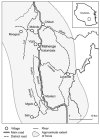High Prevalence of Glaucoma among Patients in an Onchocerciasis Endemic Area (Mahenge, Tanzania)
- PMID: 36145478
- PMCID: PMC9501165
- DOI: 10.3390/pathogens11091046
High Prevalence of Glaucoma among Patients in an Onchocerciasis Endemic Area (Mahenge, Tanzania)
Abstract
Onchocerciasis is known to cause skin lesions and blindness, but there is also epidemiological evidence that onchocerciasis is associated with epilepsy, including nodding syndrome. We carried out ocular exams in persons with epilepsy in Mahenge, an onchocerciasis endemic area with a high prevalence of epilepsy in Tanzania. We recruited 278 consecutive persons with epilepsy attending the epilepsy clinic at Mahenge hospital and satellite clinics in rural villages. They underwent a general physical and a detailed ocular examination and were tested for onchocerciasis Ov16 IgG4 antibodies. Glaucoma was defined by a raised intraocular pressure above 21 mmHg with evidence of typical glaucomatous disc changes in one or both eyes. Among the 278 participants, median age 27 (IQR 21-38) years, 55.4% were female; 151/210 (71.9%) (95% CI: 65.3-77.9) were Ov16 positive. The most frequent ophthalmic lesions were glaucoma (33.1%), vitreous opacities (6.5%) and cataracts (2.9%). In multivariate analysis, glaucoma (adjusted IRR = 1.46; 95% CI: 1.24-1.70) and age (adjusted IRR = 1.01; 95% CI: 1.01-1.02) were significantly associated with onchocerciasis. In conclusion, a high prevalence of glaucoma was observed among Ov16 positive persons with epilepsy. Persons with epilepsy with O. volvulus infection should undergo screening for glaucoma to prevent one of the causes of preventable blindness.
Keywords: Tanzania; epilepsy; glaucoma; nodding syndrome; onchocerciasis; prevalence; visual acuity.
Conflict of interest statement
The authors declare no conflict of interest. The funders had no role in the design of the study; in the collection, analyses, or interpretation of data; in the writing of the manuscript; or in the decision to publish the results.
Figures
Similar articles
-
Nodding syndrome, a case-control study in Mahenge, Tanzania: Onchocerca volvulus and not Mansonella perstans as a risk factor.PLoS Negl Trop Dis. 2023 Jun 20;17(6):e0011434. doi: 10.1371/journal.pntd.0011434. eCollection 2023 Jun. PLoS Negl Trop Dis. 2023. PMID: 37339148 Free PMC article.
-
High prevalence of epilepsy in two rural onchocerciasis endemic villages in the Mahenge area, Tanzania, after 20 years of community directed treatment with ivermectin.Infect Dis Poverty. 2018 Jun 20;7(1):64. doi: 10.1186/s40249-018-0450-3. Infect Dis Poverty. 2018. PMID: 29921319 Free PMC article.
-
Clinical presentation of epilepsy in six villages in an onchocerciasis endemic area in Mahenge, Tanzania.Epileptic Disord. 2019 Oct 1;21(5):425-435. doi: 10.1684/epd.2019.1093. Epileptic Disord. 2019. PMID: 31649005
-
Onchocerciasis-Associated Epilepsy, an Additional Reason for Strengthening Onchocerciasis Elimination Programs.Trends Parasitol. 2018 Mar;34(3):208-216. doi: 10.1016/j.pt.2017.11.009. Epub 2017 Dec 26. Trends Parasitol. 2018. PMID: 29288080 Review.
-
Mortality among persons with epilepsy in onchocerciasis-endemic and non-endemic areas of sub-Saharan Africa: A systematic review and meta-analysis.Seizure. 2023 Aug;110:253-261. doi: 10.1016/j.seizure.2023.07.006. Epub 2023 Jul 10. Seizure. 2023. PMID: 37451075
Cited by
-
Nodding syndrome, a case-control study in Mahenge, Tanzania: Onchocerca volvulus and not Mansonella perstans as a risk factor.PLoS Negl Trop Dis. 2023 Jun 20;17(6):e0011434. doi: 10.1371/journal.pntd.0011434. eCollection 2023 Jun. PLoS Negl Trop Dis. 2023. PMID: 37339148 Free PMC article.
References
-
- World Health Organization Guidelines for Stopping Mass Drug Administration and Verifying Elimination of Human Onchocerciasis: Criteria and Procedures. [(accessed on 20 July 2022)]. Available online: https://www.who.int/publications-detail-redirect/9789241510011. - PubMed
-
- World Health Organisation Onchocerciasis 2021. [(accessed on 20 July 2022)]. Available online: https://www.who.int/news-room/fact-sheets/detail/onchocerciasis.
Grants and funding
LinkOut - more resources
Full Text Sources



